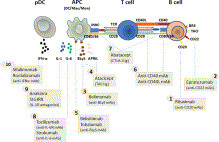Abstract
Objective
The CD4+ T cell immune response plays a pivotal role in the immunopathogenesis of human and experimental lupus nephritis, but the contribution of the Th17/interleukin-17 (IL-17) immune pathway to renal tissue injury in systemic lupus erythematosus (SLE) remains to be elucidated. The aim of this study was to characterize the function of the Th17/IL-17A immune response in 2 murine models of lupus nephritis.
MethodsIL-17A–deficient MRL/MPJ-Faslpr/2J (MRL/lpr) mice were generated, and the clinical course of nephritis was monitored by assessing the levels of albuminuria, extent of renal tissue injury, and functional parameters. In addition, lupus-prone (NZB × NZW)F1 (NZB/NZW) mice were treated with anti–IL-17A and anti–interferon-γ (anti-IFNγ) antibodies, and their effects on the clinical course of lupus nephritis were assessed.
ResultsCharacterization of renal IL-17A–producing and IFNγ-producing T cells in MRL/lpr and NZB/NZW mice revealed low numbers of infiltrating CD3+IL-17A+ cells. Renal IL-17A was mainly produced by CD4/CD8 double-negative CD3+ T cells and CD4+ Th17 cells. In contrast, the number of renal CD3+IFNγ+ cells continuously increased over time and largely consisted of typical CD4+ Th1 cells. IL-17A deficiency did not affect the morphologic or functional parameters in MRL/lpr mice with lupus nephritis, nor did IL-17A neutralization affect the clinical course of nephritis in NZB/NZW mice, but anti-IFNγ treatment attenuated the severity of the disease.
ConclusionThe Th17/IL-17A immune response plays no major role in the immunopathogenesis of lupus nephritis in MRL/lpr and NZB/NZW mice. Thus, the results of this study do not support the hypothesis that IL-17A targeting could be an intriguing new therapeutic approach for the management of proliferative lupus nephritis in SLE patients.
Via Krishan Maggon



 Your new post is loading...
Your new post is loading...
















Systemic Lupus Erythematosus
Function of the Th17/Interleukin-17A Immune Response in Murine Lupus NephritisTilman Schmidt1,†, Hans-Joachim Paust1,†,Christian F. Krebs1, Jan-Eric Turner1,Anna Kaffke1, Sabrina B. Bennstein1,Tobias Koyro1, Anett Peters1, Joachim Velden2, Stefanie Hünemörder1, Friedrich Haag1, Oliver M. Steinmetz1, Hans-Willi Mittrücker1, Rolf A. K. Stahl1 andUlf Panzer1,*Article first published online: 28 JAN 2015
DOI: 10.1002/art.38955
Copyright © 2015 by the American College of Rheumatology
Issue
Arthritis & RheumatologyVolume 67, Issue 2, pages 475–487, February 2015